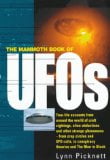 The Mammoth Book of UFO’s
The Mammoth Book of UFO’s
by Lynn Picknett
Carroll & Graf Publishers, £7.50, ISBN 078670800X
Separating the hundreds of rubbishy UFO books from the true reference books is a feat in itself.
Further narrowing down to those that fundamentally add something to the field leaves a mere handful. Only one encyclopaedic reference, detailing dates, locations and witnesses, is needed to grasp the vastness of the phenomena. Clark’s three volume set springs to mind; other authors include Vallée, Hynek, and Evans. Whether these current titles ultimately add something to the field, like UFOs, remains to be seen. Firstly, Randles’ handbook delivers its promise of 100 photographs (I counted them).
Picknett’s stands out as having no photos or other illustrations, thereby hindering any assessment of cases where photographic evidence is the focus. Aside from the catalogue format of cases, both authors attempt to provide natural explanations for the wealth of reports. Randles provides us with a fascinating chapter on IFOs (Identified Flying Objects) and an interesting flow diagram.
The diagram begins with the shape of the apparent UFO (i.e. lights, disc, or tube) then takes the witness through a series of questions to determine whether it’s actually a balloon, aircraft, satellite, bird, meteor or planet. This diagram is annoyingly rehashed in text form elsewhere in the book in a pointless chapter entitled ‘UFO recognition’.
The Mammoth Book, however, delivers 60 pages of explanations ranging from the Extraterrestrial Hypothesis (ETH), through various IFOs and psychological theories, to the wonderful Charles Bonnet Syndrome (CBS), a little-known mental condition giving rise to ‘otherworldly’ visions. The cases in ‘The Mammoth Book’ are presented in a writing style that is frustratingly chatty, and constantly questioning, preventing accurate comparison between key cases or a ready acceptance of all the facts. Despite this, the research on the subject matter has obviously been comprehensively conducted, supported by various named advisors including Kevin McClure, John Spencer, Dr Jacques Vallée and Hilary Evans. Likewise, Jenny Randles has had a prolific impact on ufology since the 1980s and has revealed a knowledge and field-active expertise unmatched today. Do these books add anything to the field? If you are fascinated by ufology, have the photographs from one book and text from the other on your shelf, then maybe they offer convenience. But if you’re not interested in ufology, look away…

